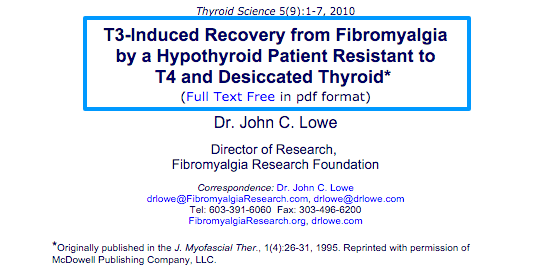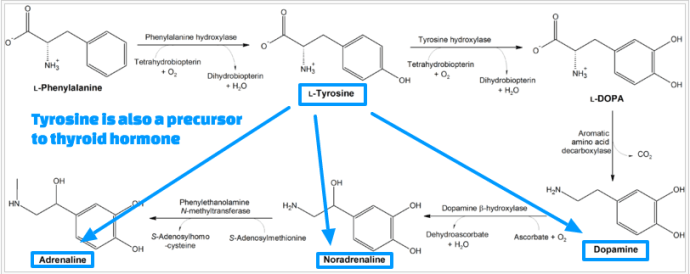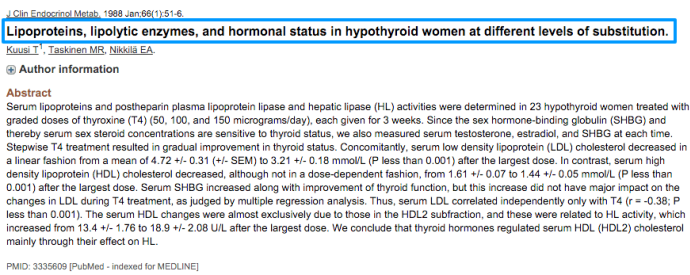Is your intuition telling you that your hypothyroidism or Hashimoto’s is causing your chronic pain? I’ve got news for you.. your intuition may be right.
Let me show you how hypothyroidism causes chronic pain… but most importantly, let me help you learn how to fix it! To start understanding how this works, you really need to understand the concept of Tissue Level Hypothyroidism…
Tissue Level Hypothyroidism: What Is It?
(Dr. Mercola and Dr. Lowe discuss the relationship between Chronic pain, Fibromyalgia and Hypothyroidism)
Chronic pain in the setting of untreated Hypothyroidism or Hashimoto’s disease usually points to tissue level hypothyroidism.
Tissue level hypothyroidism refers to the idea that you can have adequate levels of thyroid hormone floating around in your blood stream. But, because of inflammation or other causes, it isn’t able to get into the cells to turn on your genes. This is also known as Thyroid Resistance and it’s probably one of the most commonly missed (or ignored) thyroid conditions.
Standard laboratory tests can only measure what is happening in the blood stream. But, we don’t care what’s happening in the blood stream because thyroid hormone has to get into cells to do its job!
If you have adequate thyroid hormone floating around in the blood, but none of it can get into your cells, then you have what’s known as tissue level hypothyroidism.
The Link Between Fibromyalgia, Chronic Pain and Hypothyroidism
This is especially true if you’ve been diagnosed with Fibromyalgia. You see, chronic pain and Fibromyalgia accompany each other. However, no one has been able make the connection as to how or why. If you actually look at the symptoms of Fibromyalgia and Hypothyroidism side by side, you begin to see something amazing: Fibromyalgia and Hypothyroidism present in almost the exact same way.
Fortunately, there was a researcher named Dr. Lowe who put this all together for us. He linked tissue level hypothyroidism as one of the main causes of Fibromyalgia through a concept known as deductive formulation.
‘Deductively Formulated Theory is a method of problem solving that takes all of the competing theories that cause a disease and, with the help of mathematical analysis, pumps out the hypothesis that is most likely to be correct. (This is the same logic that Albert Einstein used to come up with his hypothes, including the theory of relativity).
Dr. Lowe also showed that the majority of patients who fell into this category really needed some form of T3 therapy to have resolution of their symptoms.
His data showed that approximately 2/3 of his patients improved on Natural Dessicated Thyroid Hormone (Medication like Armour thyroid, Westhroid and Naturethroid) and another 1/3 required higher doses of T3 only therapy(Liothyronine or sustained release T3).[1]

(Up to 1/3 of patients with Fibromyalgia failed to improve on NDT and required T3 therapy!)
He found that the pain of fibromyalgia could only be reversed if patients were on a high enough dose of thyroid hormone (exact dosing is highly variable and individualised).
How to Know If You Have Tissue Level Hypothyroidism
Unfortunately, thyroid hormone level blood testing is not 100% accurate. As a result, it’s best to use a combination of serum markers as well as Physical exam findings and subjective symptoms to diagnose tissue level hypothyroidism. The most commonly reported symptoms include:
1. Fatigue
The thyroid hormone is involved in the production of dopamine. If you have low levels of thyroid hormone, you will have low levels of dopamine, which can result in the symptom of chronic fatigue.

Thyroid hormones help your body convert Tyrosine to Dopamine, Norepinephrine and Epinephrine. You may know some of these hormones as “adrenaline,” which helps to set the metabolism of your body and is required for the “fight or flight” response.
2. Weight gain
Under normal circumstances, thyroid hormone helps your body burn fat by increasing the effectiveness of lipolytic enzymes (enzymes that break down fat).[2] When thyroid hormone is low, these enzymes are also low resulting in the inability to break down fat molecules – making it almost impossible to lose weight.

(Thyroid hormone increases enzymes that help you burn fat. When thyroid levels are low, your cholesterol will increase and metabolism will slow down.)
3. Hair Loss
It is well known that thyroid hormone is required for both hair growth and proper pigmentation.[3]
When there isn’t enough thyroid hormone in the body not only will you be unable to grow new hair, you will also be unable to absorb nutrients required for hair growth (like zinc). Such a deficiency can lead to further hair loss and turn into a vicious cycle.

(On its own, a low thyroid hormone level can lead to hair. But, it can also lead to nutrient deficiencies necessary for hair growth, so it’s a double whammy.)
4. Muscle Tension and Trigger Points
In order for muscles to relax, your body must produce enough ATP (also known as the body’s energy currency).
Thyroid hormone is responsible for this energy production and having a low thyroid hormone level means having a low production of energy. This inability to relax your muscles often results in trigger point formation and muscle tension or pain.

5. Delayed Relaxation Phase of Deep Tendon Reflexes
One of the most sensitive markers for tissue level hypothyroidism is this physical exam finding.
When tissue levels of thyroid are low, it results in the inability of your muscles to relax quickly. This, in turn, causes a slow relaxation phase when checking deep tendon reflexes.[4] (Deep tendon reflexes are what happens when your doctor hits your knee with that hammer-like instrument).
If you are suffering from any of these symptoms, plus chronic pain or you have been diagnosed with fibromyalgia, there is a chance you may have tissue level hypothyroidism!
What Can I Do to Treat Tissue Level Hypothyroidism?
Dr. Lowe created a treatment regimen which allowed him to put his patients’ tissue level hypothyroidism symptoms and chronic pain into complete remission.
I have tailored his approach and added some areas to it and have had great success in treating patients with both chronic pain and Fibromyalgia in my practice:
- Getting on the right dose and type of thyroid medication. Most people with chronic pain will need some form of T3 therapy, such as NDT or liothyronine.
- Exercising to tolerance. This means exercising to maximum intensity. Even if that means jogging down the street for 10 seconds! You must be placing physiologic demand on your body to change your genes and balance hormone levels.
- A real, whole food nutritious diet. Avoid highly processed foods and focus on fruits and veggies. If it has a food label or more than 1 ingredient, leave it out.
- Trigger point therapy (either by massage or through trigger point injections). In order to reduce pain, these points must be taken care of otherwise they will potentiate further pain and muscle spasm.
- Replacement of nutritional deficiencies. Most commonly, people end up needing high doses of B complex vitamins, Zinc, Iron and Magnesium. Remember, deficiencies are highly variable, so get tested!
Quick Tip: Remember that lab tests are not the best way to diagnose Tissue Level Hypothyroidism. Focus on a combination of lab tests, subjective symptoms, basal body temperature and metabolic function for diagnosis and management.
For more helpful tips on how to treat your thyroid and all your bodies hormones, plus your adrenal glands, watch this informative video by our local nutritionist and naturopathic doctor:
I Want to Hear From You
How did you overcome your chronic pain? Did it improve when you changed medications? What dose and type of medication are you on? What’s currently working for you?
For all those chronic pains, we suggest using Activations Ease naturally pure magnesium oil for natural and effective pain relief. Within 2-3 simple sprays and a few minutes, inflammation goes down and soreness starts going away.

